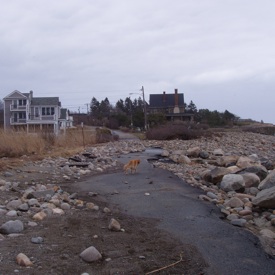There are several obvious reasons to avoid siting roads and utilities in hazard-prone areas:
- Roads and utilities are absolutely critical during evacuation, disaster response, and recovery. If they’re flooded or damaged, they can become yet another liability, rather than an asset.
- Placing public infrastructure in areas where it may be damaged makes it extremely likely that your community will end up repairing it—an added strain to municipal staff, budgets, and available services.
- Putting public infrastructure (e.g., water and sewer) in a hazard-prone area increases the likelihood that the area will be developed, or that existing development will be expanded, thereby putting more structures and people at risk.
Use the best available hazard information when evaluating where to place new roads (considering the limitations of FIRMs). When possible, keep the roads out of areas that are known to flood or are otherwise hazardous.
 * Your community needs only 500 points to qualify for reduced flood insurance premiums through the Community Rating System (CRS). For more information (including how to apply for the CRS program), see our Community Rating System (CRS) primer.
* Your community needs only 500 points to qualify for reduced flood insurance premiums through the Community Rating System (CRS). For more information (including how to apply for the CRS program), see our Community Rating System (CRS) primer.
Notes from the folks at CRS:
“While there is no specific credit for keeping roads and utilities out of the SFHA, CRS credit is provided if development and fill are prohibited and the area is maintained as open space.”

